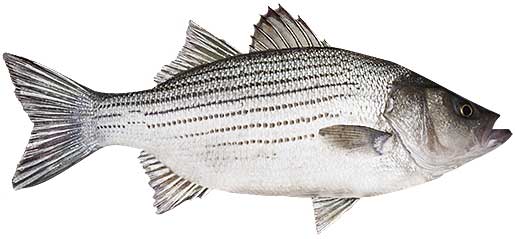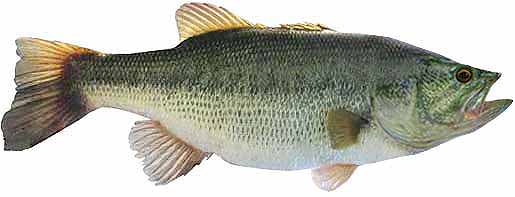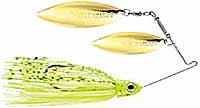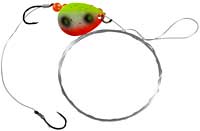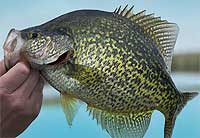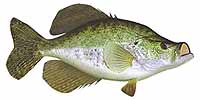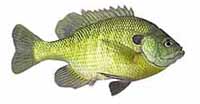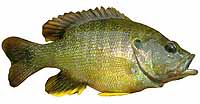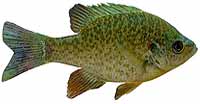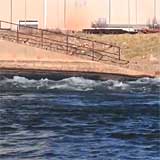Fishing Report For Sooner Lake, OK
By Rick Seaman
July 28, 2025
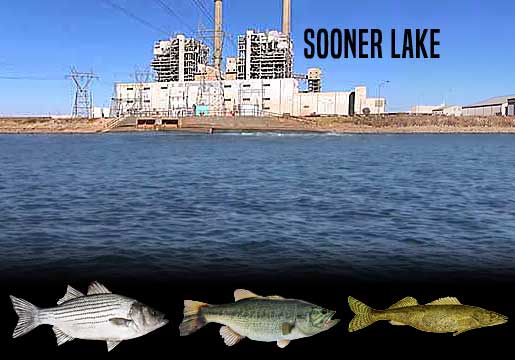
Fishing Reports
Popular Fish Species Sooner Lake, OK
NOTE: The lake is currently closed, due to poor water conditions, but should open soon.
Hybrid Striped Bass
Current Report: Good To Very Good
SUMMER. These wipers typically hang out in 8 to 30 feet of water, staying close to schools of bait. Sometimes during the heat of the day they move close to the bottom, 40 feet deep or deeper. Morning often draws hybrid stripers to much shallower water, so look for them near the surface as they feed on shallow, roaming schools of threadfin shad and gizzard shad. Being successful at fishing for stripers in Summer is often a matter of locating schools of bait, and the wolf packs of wipers are likely to be nearby. Fish finders, and sonar electronics, are a big help in locating these roaming schools. Nice wipers are being caught by casting, trolling or drift fishing. Spoons, blade baits, crankbaits, live bait and cut bait are all effective here.
FALL. In Fall, hybrid stripers return to the upper end of the lake, into inflowing water if available. Look for deeper sections in the upper river channels, and fish them thoroughly. Most any lure that resembles shad will catch wipers at this time of year.
WINTER. In Winter, hybrid stripers again hang out in deeper water and feed close to the bottom. Warm afternoons occasionally draw stripers shallower, so look for them around the 10 to 20-foot range as they feed on roaming schools of threadfin shad and gizzard shad. Some of the best activity is often around the discharge port of the power station. In Winter it is important to locate schools of bait, then look for wipers schooling below the bait. Fish finders, and forward facing sonar, are a big help in locating these roaming schools. Nice fish are being caught while trolling or drift fishing. Spoons, swimbaits, blade baits, crankbaits, live bait and cut bait are typically effective this time of year. Due to slower metabolism, anglers are triggering more strikes by making slower presentations.
SPRING. When water temperatures rise into the mid 60's now, it's the ideal time for the hybrid stripers to spawn. The lake is loaded with hybrids averaging 2 to 5 pounds, with plenty of 8 pound plus fish being caught. In Spring, work the upper end of the lake, especially if there is inflowing water. If they spawn, this is where they will lay eggs in the flowing water. Look for deeper holes in the river channels, as they are a good holding place for stripers.
Largemouth Bass
Current Report: Closed
SUMMER. This time of year, bass are feeding shallow early and late in the day, where they are typically caught on topwater, crankbaits and swimbaits. Drop-shots and wacky-rigged stick worms catch finicky bass when the bite is slow. Largemouth bass here feed on gizzard shad, threadfin shad, small sunfish and crawfish. During the hotter parts of the day, they hold on points, channel edges, and ledges 15 to 25 feet deep.
FALL. As Fall arrives, bass here will follow schools of baitfish into shallow coves and bays, where spoons, swimbaits, and slow-rolled spinnerbaits have been successful in prior years.
WINTER. The warm water from the power plant spillway, attracts bass and baitfish during cold Winter months, otherwise they will isolate around slightly deeper structure, flats, points and creek channels. They can be found around 20 to 30 feet deep. Here they hold, feeding less frequently, awaiting warmer water to return in Spring.
SPRING. Once water temperatures rise into the low 60's, largemouth will move from deep wintering spots to shallower water just outside spawning areas. Jerkbaits, spinnerbaits and vibrating jigs typically get bites just away from the shoreline. At this time they are focused on the spawn. Once water warms into the mid to high 60's, they will move into 1 to 4 feet of water, and create nests, then lay their eggs. Immediately afterwards, females move to deeper water and males remain to guard the eggs, and then the fry. After a couple weeks, the males also move to slightly deeper water. Buzzbaits, crankbaits, vibrating jigs, plastic worms and swimbaits are good for catching bass during this period.
Saugeye
Current Report: Fair To Good
Spring and Fall are the best seasons for catching saugeye, as they spend a great deal of time in shallow water.
SUMMER. Currently the water temperature is in the 70's, and saugeye fishing should be decent. Throughout Summer, early in the morning, and from dusk until long after dark, are the best times to catch saugeye, as they move shallower to feed. Anglers normally report good catches on crankbaits, worm harnesses and jigs tipped with minnows. They are being caught up shallow around the mouth of coves, and on shallow flats, early and late. The rest of the time they are cruising flats and creek channel edges, where they are harder to locate. Most saugeye caught during the middle of the day are holding in 20 to 30 feet of water, where deep diving crankbaits, blade baits and jigs tipped with minnows all work well.
FALL. Fall brings cooler temperatures to shallow water, drawing saugeye and baitfish into the shallows. Jigs, swimbaits, spoons, crankbaits, jerkbaits and spinnerbaits are all catching saugeye again.
WINTER. This Winter, fishing for saugeye was slow. Saugeye often migrate to moving water, during winter, and are caught nearby the power plant warm-water outlet. They primarily feed on threadfin shad, gizzard shad and other small fish, close to the bottom. Blade baits, jigs, swimbaits, spoons, deep-diving crankbaits, and worm harness spinners all catch saugeye while trolling or slow drifting.
SPRING. Anglers will find saugeye in the shallows, especially rocky areas and inlet channels, where they will spawn once the water warms to the mid 40's. Afterwards, they move to shallow points, flats, shoals and ledges just off shore, nearby their spawning location. Bright colored jigs, tipped with minnows or nightcrawlers are catching them in 5 to 15 feet of water. Spinnerbaits, jerkbaits and crankbaits are also working when saugeye are up shallow.
Fishing Video
Fish species to fish for...
Guide to fishing for largemouth bass, channel catfish, flathead catfish, blue catfish, black crappie, white crappie, saugeye, bluegill, green sunfish and redear sunfish and hybrid striped bass at Sooner Lake in Oklahoma.
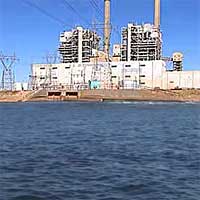
Sooner Lake is a 5,000-acre reservoir with over 40 miles of shoreline. This power plant lake offers year-round fishing for hybrid stripers, largemouth bass, catfish, crappie, saugeye and sunfish. There are areas for fishing from the bank, all around the lake.
Primary fish species to catch
Click images for fishing tips and details about each species.
Today's Weather & Forecast
Public Boat Launch Ramps & Landings
Click here for boat ramps.
Fishing License
Click here for a Oklahoma Fishing License.
Map - Fishing & Access
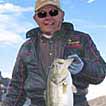
Rick Seaman is a fishing enthusiast with over five decades of fishing experience, a retired tournament fisherman, author of numerous published articles on fishing, and co-author of the book "Bass Fishing - It's not WHAT you throw, It's WHERE you throw it".
Contact Information
Sooner Lake
OK Dept of Wildlife Conservation
1801 N. Lincoln
OKC, OK 73105
580 304-9243
Fishing lakes in each state
072825
Sooner Lake, OK Report
OKLAHOMA


Fishing for crappie and largemouth bass in north-central OK.


